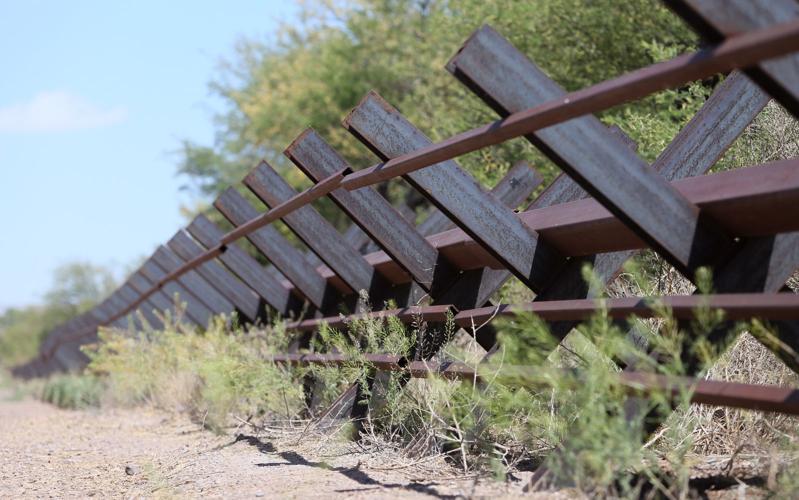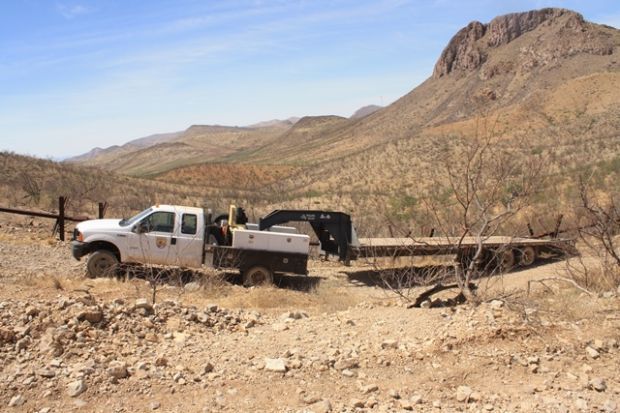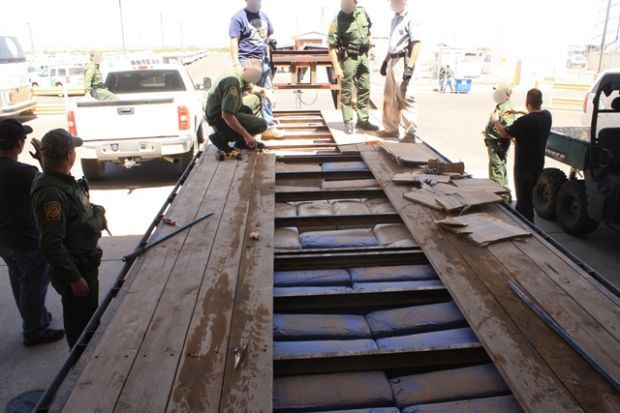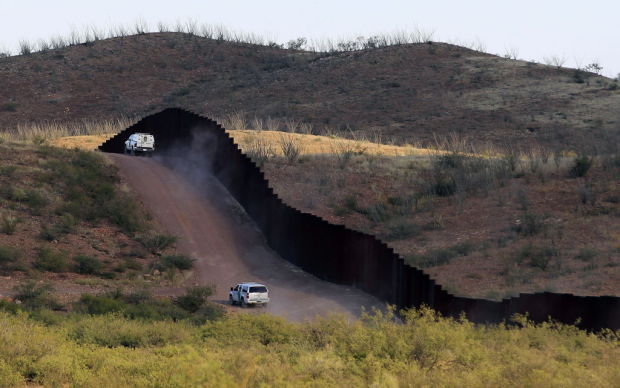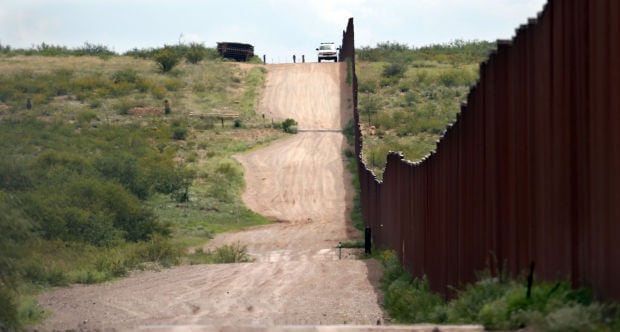Federal authorities are targeting a drug-trafficking organization that reportedly smuggles 10,000 pounds of marijuana through Cochise County every month.
Two cases in U.S. District Court in Tucson shed light on a decade of brazen cross-border smuggling by the Agua Prieta, Sonora-based Toscano-Siqueiros drug-trafficking organization.
Federal prosecutors say Leonel “Tiger” Toscano and Martin “Tin Tin” Siqueiros run an organization that specializes in “drive-through” smuggling, in which convoys of trucks and SUVs loaded with thousands of pounds of marijuana drive across the border and head to Tucson or other destinations.
In drive-throughs, smugglers drive vehicles over ramps placed on top of the border fence, cut holes in the fence and drive through the breaches, or drive across areas with little or no fencing, court records show.
After crossing the border, scouts with encrypted radios alert drivers to law enforcement efforts. The drivers wear laminated cards around their necks that list code words to decipher the scouts’ messages, according to court documents.
Federal prosecutors filed drug-trafficking charges against nine men in connection with busts in November 2015 and January 2016. Prosecutors say they were drivers for the Toscano-Siqueiros organization.
“This drive-thru crew has been operating in the Southern Arizona area with little to no consequences for many years,” federal prosecutor Christina Vejar wrote in court documents.
“The government views these cases as an opportunity not only to significantly hinder their operations (since many of their seasoned drivers and operatives were arrested in these two cases), but also as an opportunity to send a strong message of deterrence to the associates of these individuals who have yet to be apprehended,” Vejar wrote.
Investigators linked them to the Toscano-Siqueiros organization based on previous arrests, the suspects’ comments to law enforcement, fingerprints found on abandoned drug-smuggling vehicles and the testimony of a cooperating defendant.
In one case, authorities used a cellphone video made by a driver during a smuggling attempt to incriminate him.
Five defendants signed plea agreements and will be sentenced in the coming months, court records show. Another four defendants pleaded guilty and were sentenced to seven or 10 years in prison, depending on each defendant’s criminal history.
Under cover of darkness
The bust of an 8,300-pound load of marijuana began when a sensor in the desert near Douglas alerted Border Patrol agents around 6:30 a.m. Nov. 2, 2015.
When agents arrived to the area, they saw two pickups and an SUV covered in camouflage. They were driving in tandem with their lights off.
The vehicles sped from the area amid a cloud of dust. The vehicles split up and one of the trucks went off-road and drove through a fence. The SUV turned back toward Mexico and slammed into a Border Patrol truck.
The SUV was so packed with marijuana that one of the occupants was forced to hang out of the window while the chase unfolded.
All three vehicles ended up disabled, and agents arrested Cesar Arvizu Noriega, 32; Alonzo Barrera Aguilar, 39; Mario Lopez Castillo, 33; and Jose Lopez Castillo, 29.
Several other men had fled when the SUV was disabled. An hour later, agents on horseback arrested David Cuevas Sotelo, who claimed to be a migrant making his way across the border.
Agents were immediately suspicious of the fact he was not dirty from the trek and he was carrying four cell phones, one of which contained a video of a previous drive-through.
Agents seized 8,300 pounds of marijuana stashed in the three vehicles. An unknown amount of marijuana was in the seven other vehicles that Arvizu Noriega told agents had ramped over the border fence the day before.
On Jan. 25, 2016, Border Patrol agents saw two trucks driving at night with their lights off near Douglas. The trucks peeled off in two different directions when the drivers saw the agents approaching.
After a two-hour search, agents found 2,300 pounds of marijuana inside an abandoned Ford F-250.
Agents tracked the men who abandoned the truck for five hours before they caught up with Alberto Villalobos Cheno, a 34-year-old driver who said he was going to be paid $10,000 to haul the marijuana to Tucson, and Jose Alfredo Serrano Montano, a 23-year-old who said he was going to be paid an undetermined portion of $20,000.
An agent shot Villalobos during the arrest, as the Star reported at the time.
Villalobos told authorities he tripped and the agent mistook his movement as aggressive, court records show. Agents said he struggled with an agent while trying to flee. In the process, he threw dirt in the agent’s eyes and pulled him toward a cliff-like embankment.
Two days later, agents found 3,800 pounds of marijuana inside a truck with its front end buried in a wash.
That night, agents arrested Luis Chavez Drew, 38, and Julio Ceasar Vargas de la Cruz, 37, as they walked toward Arizona 80 near Apache.
Chavez told agents he was going to be paid $5,000 to look out for law enforcement as they drove to Tucson. After the truck was disabled, he unsuccessfully tried to fix it and the two were waiting to be picked up by their fellow traffickers.
Vargas de la Cruz said he was working as a scout in order to waive the $4,000 smuggling fee he would have had to pay to get into the United States illegally.
Typical drive-through
Court documents sketched out 15 other drive-throughs that together accounted for 35,000 pounds of marijuana smuggled across the border.
Carlos Archuleta, assistant special agent in charge for Homeland Security Investigations in Douglas, said he could not discuss the incidents cited in court documents, but he spoke to the Star in general terms about drive-throughs in Cochise County.
Typically, the vehicles used in drive-throughs are stolen in Arizona, taken to Mexico and modified with all-terrain tires and blacked-out windows, Archuleta said. In some instances, the vehicles are disguised as U.S. government vehicles, such as those used by the Bureau of Land Management.
Among the various methods used in drive-throughs, traffickers place car-carrier ramps over vehicle barriers or pedestrian fencing at the border, he said.
In other cases, traffickers cut holes in the border fence with blowtorches while using blankets or plywood to hide the torch’s flashes from U.S. authorities.
In order to provide a safe escape route, traffickers sometimes cut an alternate hole in the fence so they can escape back into Mexico if U.S. authorities detect the primary breach.
In some cases, armed men will guard the breach on the Mexican side of the fence, he said.
In a September 2015 incident cited in court documents, Border Patrol agents in western New Mexico chased a vehicle they suspected was hauling drugs, but the driver turned back toward Mexico.
The agents pulled back their chase when a Border Patrol helicopter pilot alerted the agents on the ground that men at the border were armed with rifles as they waited for the truck to cross.
Smugglers in drive-throughs frequently carry firearms with them, Archuleta said, but the firearms are usually meant to protect themselves from “rip crews” that rob traffickers.
The shooting of Villalobos was the only incident cited in court documents where a firearm was used by an agent or a smuggler. Archuleta said drivers typically surrender to law enforcement, rather than engage in gunfights.
However, in some cases smugglers use their vehicles to ram Border Patrol vehicles. In trafficking jargon, they are called “suicideros,” or suicide drivers, Archuleta said.
The busy season for drive-throughs comes during the harvest season in the fall, when drive-through attempts increase to three or four each month in the area between the New Mexico state line and the Huachuca Mountains.
In recent years, drive-throughs have “gone way down” in Cochise County relative to other areas of the border, such as the Tohono O’odham Reservation, he said.
The Border Patrol did not respond to a request for statistics on drug seizures in Cochise County. Local law enforcement did not respond to requests for information about how the drive-throughs affect the local community.
Tucson bust
One case cited in court documents shows how Tucson is connected to the drive-throughs.
In August, Tucson police arrested Jorge Erick Saenz Martinez, 27, aka “The Blowtorch,” after a concerned citizen called 911 and said someone was putting marijuana in his trash can.
Inside the can, police found junk mail mixed in with plastic wrapping covered in marijuana residue. The junk mail led them to a residence where Saenz Martinez, 27, answered the door.
Saenz Martinez had been arrested in Glendale in 2013 after agents busted four vehicles carrying 13,700 pounds of marijuana in Cochise County. He and several others had fled the bust and gone to see a soccer game in Glendale.
Fingerprint evidence connected Saenz Martinez to the abandoned truck found with a load of marijuana during the Nov. 2, 2015, drive-through.
In Tucson, Saenz Martinez fled on foot when officers asked him about the marijuana odor coming from the house.
Officers found him in a nearby house where he had ditched his clothes and taken a shower. He was found hiding under a bed, naked.
Officers said they found 230 pounds of marijuana, $68,000 in cash and two firearms at Saenz Martinez’s residence.
The money was packaged and the labels used the nicknames of members of the Toscano-Siqueiros organization, including “Tin-Tin Jefe,” the nickname of Martin Siqueiros.
Despite the prosecution of several of the organization’s transportation heads, a recent arrest shows drive-throughs continue in Cochise County.
Three men were arrested Nov. 15 in McNeal, a town 25 miles north of Douglas on Arizona 191, in connection with 3,800 pounds of marijuana seized from two pickup trucks found abandoned after a chase by Border Patrol agents.
Border Patrol cameras saw the men drive the vehicles through a hole cut in the border fence about a half-mile west of the Douglas port of entry. Two other vehicles that drove through the breach were not found.


